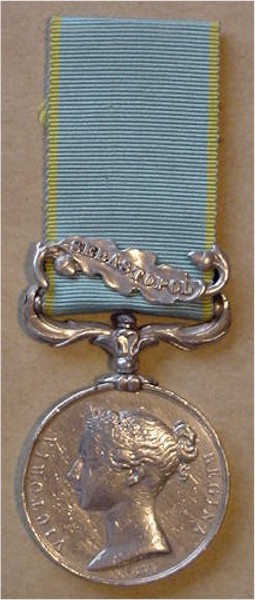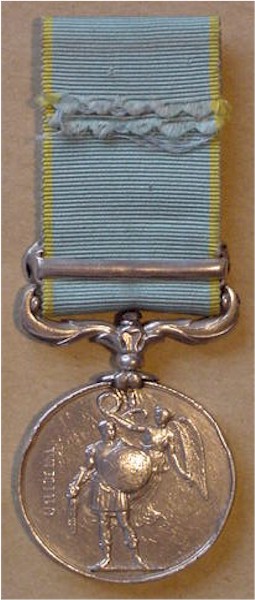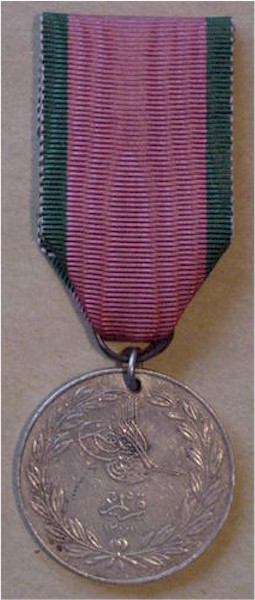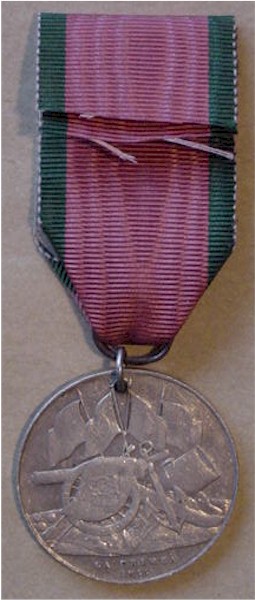

Above left, the front of the Crimea Medal awarded by the British government. Above right, the reverse side of the same medal. These images were taken from a web site and their medal ribbons are in better shape than ours. However, the medals are definitely the same as what were handed down to us.
The Crimean War Medal was sanctioned on December 15, 1854 by order of Queen Victoria. Two clasps were also authorized at this time, for the battles of Alma (September 20, 1854) and Inkermann (November 5, 1854). The clasp for the battle of Balaklava (which took place before that of Inkermann, on October 25, 1854) was not authorized until February 23, 1855. The clasp for the fall of Sebastopol (September 9, 1855) was granted on October 13, 1855. (Our medal has the Sebastopol clasp.)
The medal itself is a 36mm disc of sterling silver, bearing the diademed head of Queen Victoria on the obverse, together with the legend "VICTORIA REGINA" and the date 1854. The reverse shows a Roman legionary (carrying a gladius and circular shield) being crowned with a laurel wreath by a winged figure of Victory. To the left is the legend "CRIMEA," which is written vertically. The suspension is an ornate floriated swiveling suspender unique to the Crimea Medal; the clasps are also unique, being in the form of an oak leaf with an acorn at each extremity. The ribbon is 27mm wide, pale blue with yellow edges.
The obverse of this medal bears the diademed head of Queen Victoria with the inscription "VICTORIA REGINA" and the date 1854. The reverse shows a winged figure of Victory crowning a Roman soldier, who is holding a shield in his left hand and a sword in his right, with a laurel wreath. The word "CRIMEA" can be seen to the left while the designer's name of Wyon is visible in tiny letters to the lower right. The medal is fitted with a foliated swivelling suspender unique to this medal and sweated to the medal.
About 275,000 Crimea medals were awarded (at the time, the largest distribution ever made) to all those in the British Army, Royal Navy and Royal Marines who took part in the campaign in the Crimean peninsula, or in related service afloat. Medals could be returned to the Mint for naming (in a style known as "officially impressed"), but many were crudely stamped with names by recipients who were presented with their medals in the Crimea ("Depot impressed"), or were privately engraved by jewelers in England.
John Baxter Wighton received another medal for his service in the Crimea - this from the Sultan of Turkey.


Our medal is similar to the above except for the colours of the ribbon. Our colours are a much brighter green and a crimson red.
The Sultan of Turkey issued this medal to allied military personnel involved in the Crimean war. There are three different issues of this medal for those issued to British, French or Sardinian personnel. The obverse shows the Sultan of Turkey's cipher with the Mohammedan date for 1271 on all versions. The reverse depicts a cannon with four flags to its rear. The foremost flag (second from the left) depicts the country to which the medal was intended. The inscription in the exergue reads La Crimee 1855 for the French issue, La Crimea 1855 for the Sardinian issue and Crimea 1855 for the British Issue. The ribbon is attached through a steel ring which is attached to the medal by a smaller silver ring, however many medals are found with privately attached scroll type suspenders.
On our medal, I can't make out the imprint of the flag that is second from the left. However, I can see the third flag from the left and that one is for Britain (which it should not be). The inscription on our medal is La Crimea, 1885. Thus, it appears that John Baxter Wighton received the Sardinian issue. I found a web site that reported that many of the medals due for British recipients were lost in a ship wreck and they awarded whatever issue came to hand, with the most common being of the Sardinian type.
The original ribbon issued with this medal measured only .50" wide but was replaced by one of 1.25" when awarded to British personnel. The ribbon itself is watered and of dark crimson with green edges. (Our ribbon is 1.25 inches and its colours are closer to crimson than the one in the picture above.)
Sources
Various web sites, including:
The Crimea Medal pictures were found at a site for collectors of British military medals: http://www.britishmilitarymedals.co.uk/crimeanmedal.htm
The Turkish Crimea Medal pictures were found at the same site but on a different page: http://www.britishmilitarymedals.co.uk/turkishcrimeanmedal.htm
General information on the Crimea Medals was found at: http://www.btinternet.com/~james.mckay/crimedal.htm